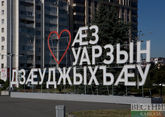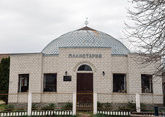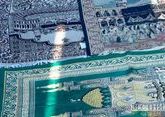The Karachays are a Turkic people of the North Caucasus, mostly situated in the Russian Karachay–Cherkess Republic. The city of Cherkessk, Ust-Dzhegutinsky district, Karachaevsky urban district, Karachaevsky district, Malokarachayevsky district, Prikubansky district, Zelenchuksky district, Urupsky District are the areas where they mainly live. The Dombai and Teberda valleys, the Elbrus region, and partially Arkhyz are their original place of residence. The oldest settlements are Kart-Dzhurt, Uchkulan, Khurzuk, Duut and Dzhazlyk. The Karachays are Sunni Muslims belonging to the Hanafi madhhab. According to the 2002 All-Russia Census, their number was 192,182 people.
There is no categorical version of the Karachay's origin. According to anthropology, they belong to the central cluster of the Caucasionic race, which is one of the sub-races of Caucasian race, like the Balkars, Ossetians, Ingush, Chechens, Bats, Avar–Andic-Tsezic peoples, some of the Mountain Jews. However, there is not enough genetic data. From the existing data, we can say that the following haplogroups dominate: R1A1 ((23.2%) Aryan) and G2 ((27.5%) Caucasian). The percentage of other haplogroups is insignificant. However, as far as is known, the selections are not large.
The Karachay people speak the Karachay-Balkar language, which belongs to the Western Turkic group, the Kipchak-Polovtsian subgroup of Turkic languages. The researchers suggest that in the ethnogenesis of the Karachais could participate the following people:
1. autochthonous Caucasian tribes;
2. Alans;
3. Bulgars;
4. Khazars;
5. Kipchaks.
This version was approved on June 22-26, 1959 at the symposium devoted to the problem of origin of Balkar and Karachay peoples, held in the city of Nalchik.
***
Karachays and Balkars
If we describe the Balkars, then we can say that they have exactly the same anthropology data, genetics data and language (not to mention the culture) with the Karachays. That is, all the classifications and definitions given to the Karachays can be attributed to the Balkars. They consider themselves as one people. To be precise, the people who are called the Balkars now acquired such a common name already after it was included to Russia. These were five mountain societies: Cherekskoe, Kholam, Bezengi, Chegemskoye and Baksanskoe (Urusbievskoe), which were governed by aristocratic families (taueys).
The most famous of them are the Abaevs, the Aidebolovs, the Zhankhotovs and the Misakovs in the Malkarian society, the Balkarukovs and the Kelemetovs in Chegem, the Shakmanovs in Kholam, the Syunyuchevs in Bezengievsky, the Urusbievs (the separated branch of Syuyunchevs) in Baksansky.
There were some differences in the language of these mountain societies. Based on these differences, the corresponding dialects were later identified. The inhabitants of the largest Chereks society were called the Balkars. They speak Karachay-Balkar with the ts–ch merger (tsokanye) ((chach (kar.) - tsats (cherk.) - hair), there are some other phonetic differences).
The Chegems and the Baksans (Urusbievites, named after the Urusbievs) speak a language that does not differ from Karachay (except for dzh–zh merger dzhash/zhash - a guy). There is the Khulam-Bezengi mixed language as well. But there are no lexical differences between these dialects. Today's literary Karachay-Balkar language was formed on the basis of the languages of Karachays, Chegems and Urusbievievs. Initially the Balkars called themselves the inhabitants of the Cherek society, the others called themselves - Taulula (mountaineers). That is, the ethnonym Balkar historically applies not to the entire Balkar people, although this is not a matter of today's self-identification, but rather of the past.
***
The Balkars are the indigenous population of Kabardino-Balkaria, which mainly lives in its mountain and foothill areas in the upper reaches of the Khaznidon, Balkar Cherek (Malarka), Cherek-Bezengi (Bezengi, Kholamtsy), Chegem (Chegems), Baksan (Baksans or Urusbievs ) and Malka rivers. They speak the Karachay-Balkar language, which is referred to the Kipchak-Polovtsian subgroup of Turkic languages. They belong to the Caucasionic race, which is one of the sub-races of Caucasian race. They are Sunni Muslims belonging to the Hanafi madhhab. Their number in Russia is 108 thousand people (2002), 105 thousand of which live in Kabardino-Balkaria (11.6% of the population of the republic).
The Balkars are one of the most high-mountainous peoples of the region. They live in the gorges and foothills of the Central Caucasus along the valleys of the Malka, Baksan, Chegem, Cherek rivers and their affluents. In fact, the Balkars are a single people with the Karachays, administratively divided into two parts. Their material culture is also identical. The only thing, because of the specifics of the gorges the Karachays built their houses of wood, while the Balkars - of stone, their ancestral princely towers and crypts of stone were preserved. Speaking of mentality, the Karachays consider the Balkars to be more cheerful, soft and joke-lovers. Balkar poet Qaysin Quli said that songs are written in Karachay, but performed in Balkaria.
***
If we talk about the self-name of Balkar, then it is difficult to correlate it with the ethnonym of the Bulgar, because in the original it sounds - malkarly. It can be correlated with the name of the Malka river in Kabardino-Balkaria. But probably it is possible to argue that the Balkars are descendants of the Bulgars. According to the legend, the Great Bulgaria under the leadership of Kubrat, which covered part of the northwestern Caucasus, disintegrated and the people were divided among his sons, so it can be more or less surely asserted that part of the Bulgars could remain in the North Caucasus (the Bulgars of Batbayan ) and contribute to the ethnogenesis of local peoples, including the Karachays and the Balkars.
The existence of the Bulgars in the foothills and partly in the mountains of Karachay-Cherkessia and Kabardino-Balkaria has some archaeological confirmation.
In this regard, it is possible to draw a symbolic line from Danube Bulgaria through the Caucasus to Volga Bulgaria and Kazan. However, given the multifaceted ethnogenesis of the majority of the peoples of the North Caucasus, especially the Karachay-Balkar people (a conditional term that has long been used), the possibility of participation of several ethnic groups in the ethnogenesis of the people, we would not affirm now that the Balkars are the Bulgars of our days. But we cannot exclude the participation of the Bulgars in this formation of the people as well.
***
By the way, modern Bulgarians, as well as Kazan Tatars, show a constant interest in this issue. We think that this topic should be subject to a separate study, which could if not confirm this version, then give additional knowledge in the relevant context, which should be welcomed.










